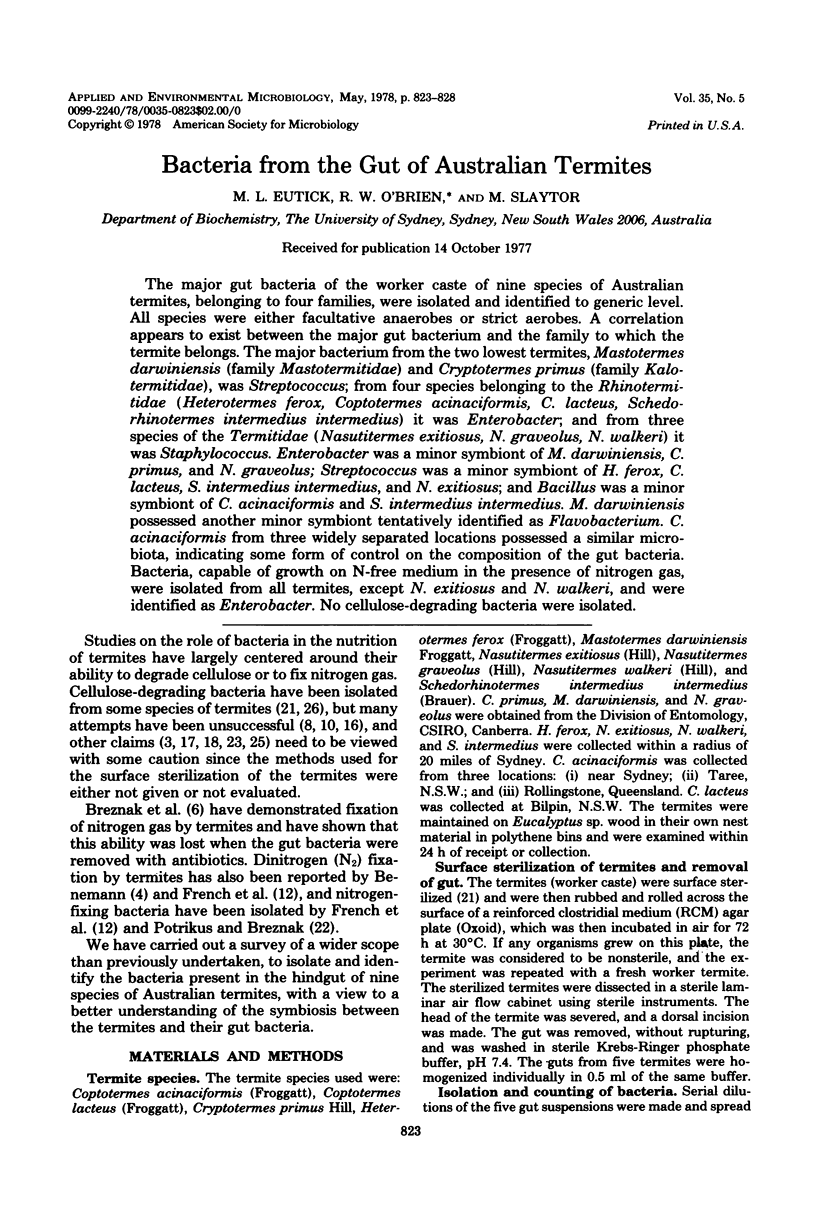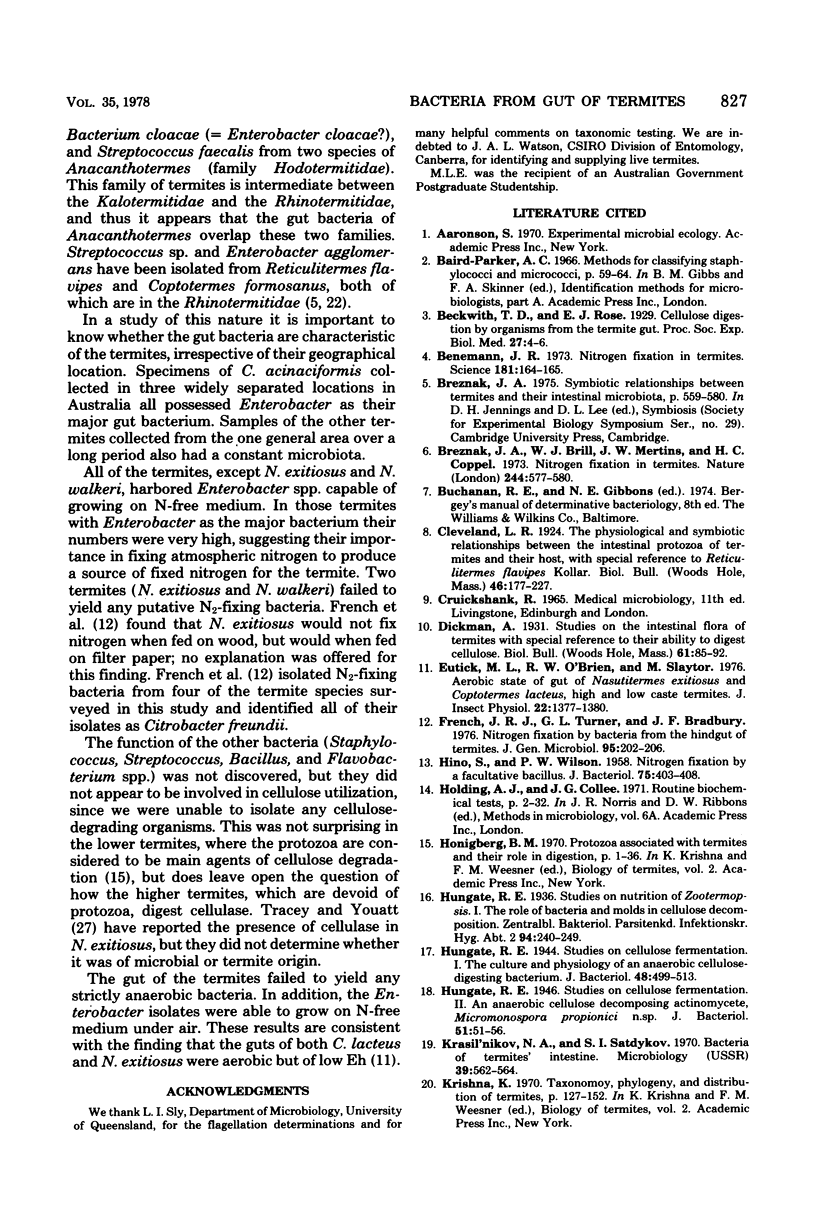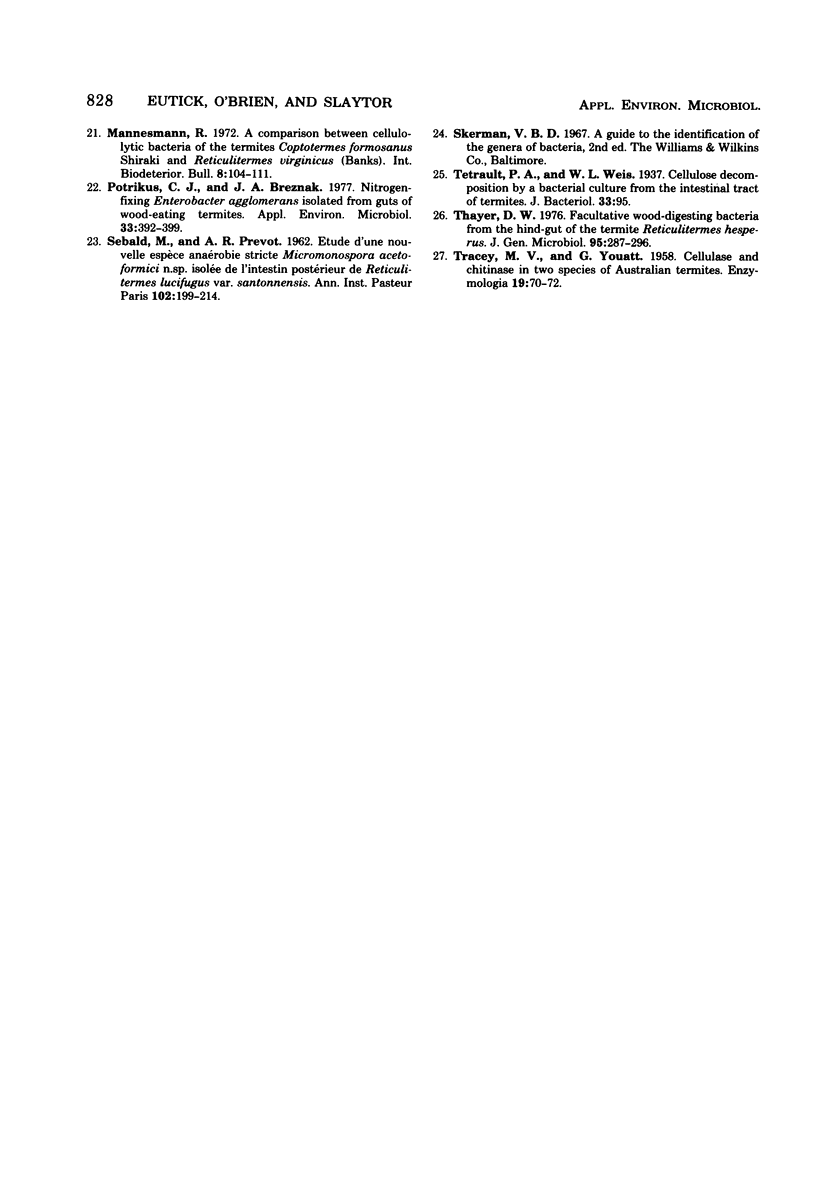Abstract
The major gut bacteria of the worker caste of nine species of Australian termites, belonging to four families, were isolated and identified to generic level. All species were either facultative anaerobes or strict aerobes. A correlation appears to exist between the major gut bacterium and the family to which the termite belongs. The major bacterium from the two lowest termites, Mastotermes darwiniensis (family Mastotermitidae) and Cryptotermes primus (family Kalotermitidae), was Streptococcus; from four species belonging to the Rhinotermitidae (Heterotermes ferox, Coptotermes acinaciformis, C. lacteus, Schedorhinotermes intermedius intermedius) it was Enterobacter; and from three species of the Termitidae (Nasutitermes exitiosus, N. graveolus, N. walkeri) it was Staphylococcus. Enterobacter was a minor symbiont of M. darwiniensis, C. primus, and N. graveolus; Streptococcus was a minor symbiont of H. ferox, C. lacteus, S. intermedius intermedius, and N. exitiosus; and Bacillus was a minor symbiont of C. acinaciformis and S. intermedius intermedius. M. darwiniensis possessed another minor symbiont tentatively identified as Flavobacterium. C. acinaciformis from three widely separated locations possessed a similar microbiota, indicating some form of control on the composition of the gut bacteria. Bacteria, capable of growth on N-free medium in the presence of nitrogen gas, were isolated from all termites, except N. exitiosus and N. walkeri, and were identified as Enterobacter. No cellulose-degrading bacteria were isolated.
Full text
PDF





Selected References
These references are in PubMed. This may not be the complete list of references from this article.
- Benemann J. R. Nitrogen fixation in termites. Science. 1973 Jul 13;181(4095):164–165. doi: 10.1126/science.181.4095.164. [DOI] [PubMed] [Google Scholar]
- Breznak J. A., Brill W. J., Mertins J. W., Coppel H. C. Nitrogen fixation in termites. Nature. 1973 Aug 31;244(5418):577–580. doi: 10.1038/244577a0. [DOI] [PubMed] [Google Scholar]
- Breznak J. A. Symbiotic relationships between termites and their intestinal microbiota. Symp Soc Exp Biol. 1975;(29):559–580. [PubMed] [Google Scholar]
- French J. R., Turner G. L., Bradbury J. F. Nitrogen fixation by bacteria from the hindgut of termites. J Gen Microbiol. 1976 Aug;96(2):202–206. doi: 10.1099/00221287-95-2-202. [DOI] [PubMed] [Google Scholar]
- HINO S., WILSON P. W. Nitrogen fixation by a facultative bacillus. J Bacteriol. 1958 Apr;75(4):403–408. doi: 10.1128/jb.75.4.403-408.1958. [DOI] [PMC free article] [PubMed] [Google Scholar]
- Hungate R. E. Studies on Cellulose Fermentation: I. The Culture and Physiology of an Anaerobic Cellulose-digesting Bacterium. J Bacteriol. 1944 Nov;48(5):499–513. doi: 10.1128/jb.48.5.499-513.1944. [DOI] [PMC free article] [PubMed] [Google Scholar]
- Hungate R. E. Studies on Cellulose Fermentation: II. An Anaerobic Cellulose-decomposing Actinomycete, Micromonospora propionici, N. Sp. J Bacteriol. 1946 Jan;51(1):51–56. [PMC free article] [PubMed] [Google Scholar]
- Potrikus C. J., Breznak J. A. Nitrogen-fixing Enterobacter agglomerans isolated from guts of wood-eating termites. Appl Environ Microbiol. 1977 Feb;33(2):392–399. doi: 10.1128/aem.33.2.392-399.1977. [DOI] [PMC free article] [PubMed] [Google Scholar]
- TRACEY M. V., YOUATT G. Cellulase and chitinase in two species of Australian termites. Enzymologia. 1958 Mar 15;19(2):70–72. [PubMed] [Google Scholar]
- Thayer D. W. Facultative wood-digesting bacteria from the hind-gut of the termite Reticulitermes hesperus. J Gen Microbiol. 1976 Aug;96(2):287–296. doi: 10.1099/00221287-95-2-287. [DOI] [PubMed] [Google Scholar]


